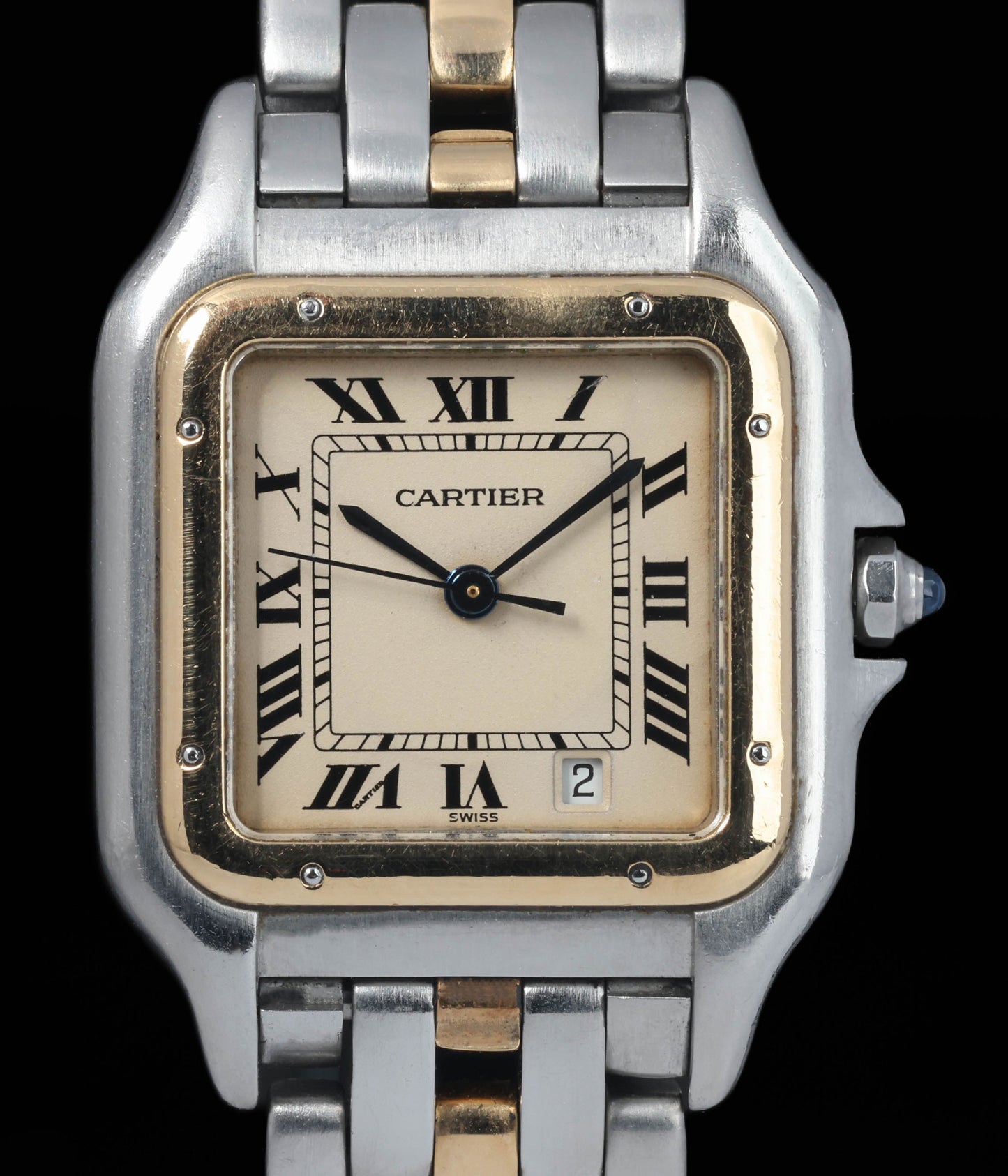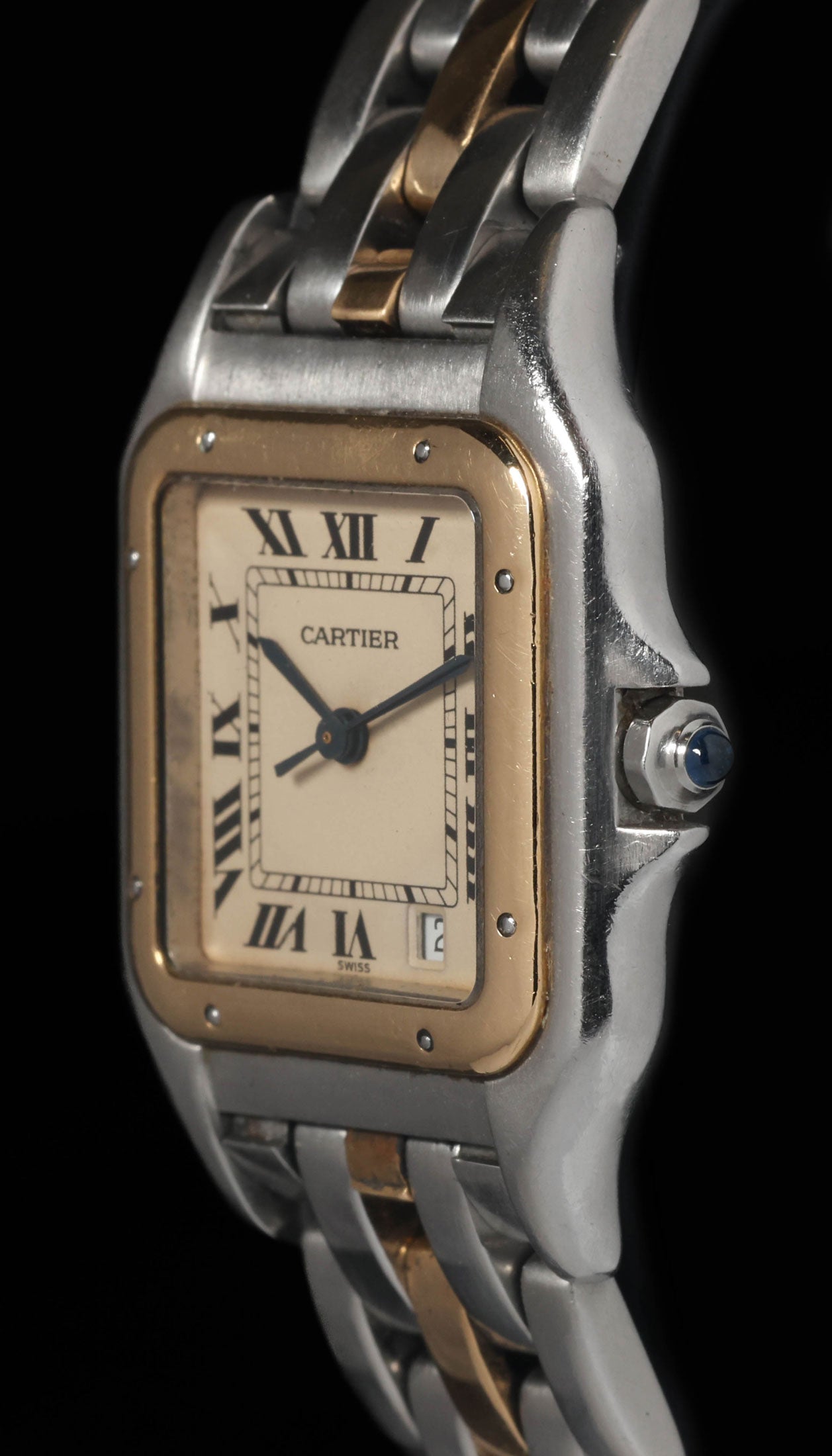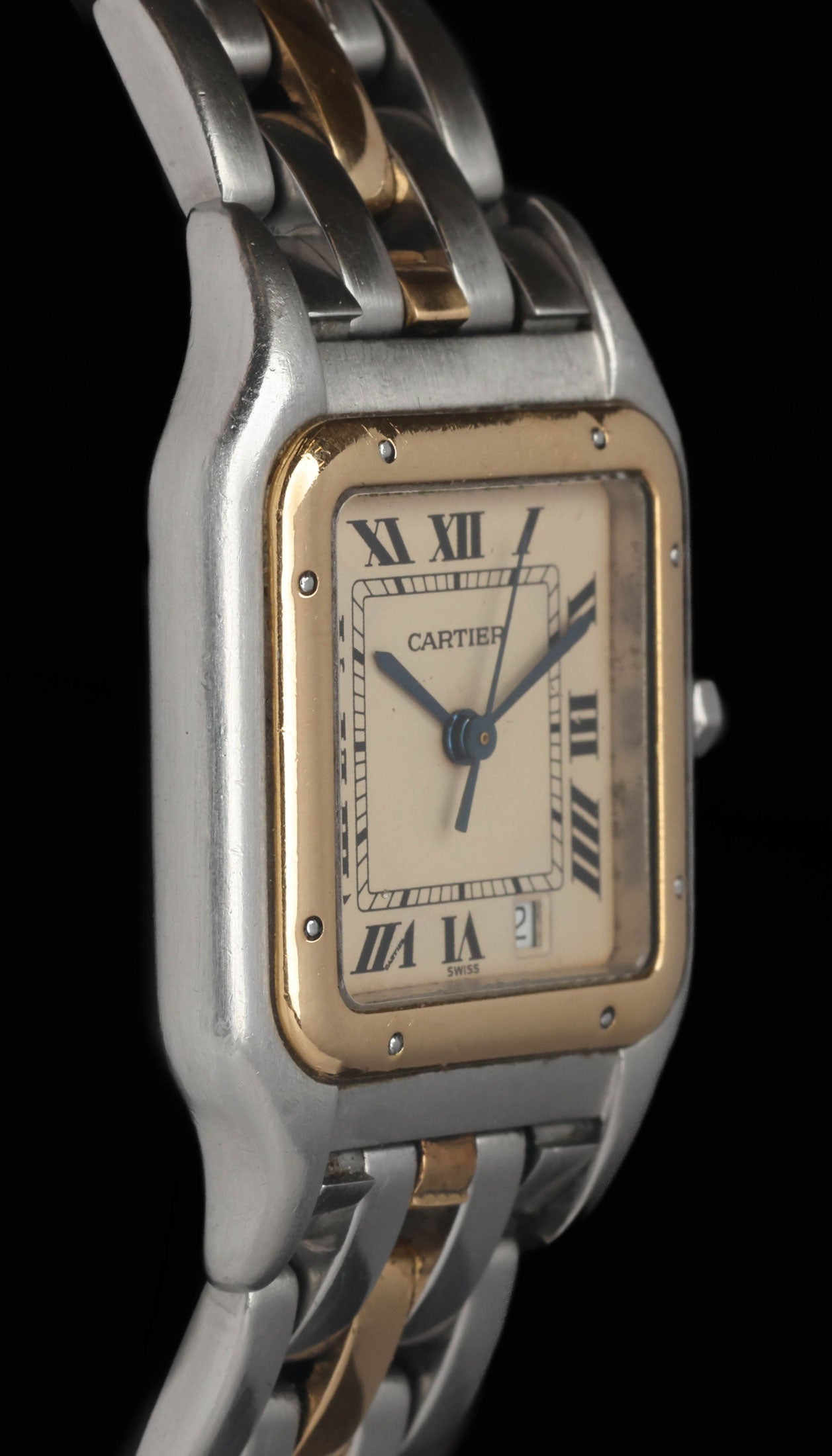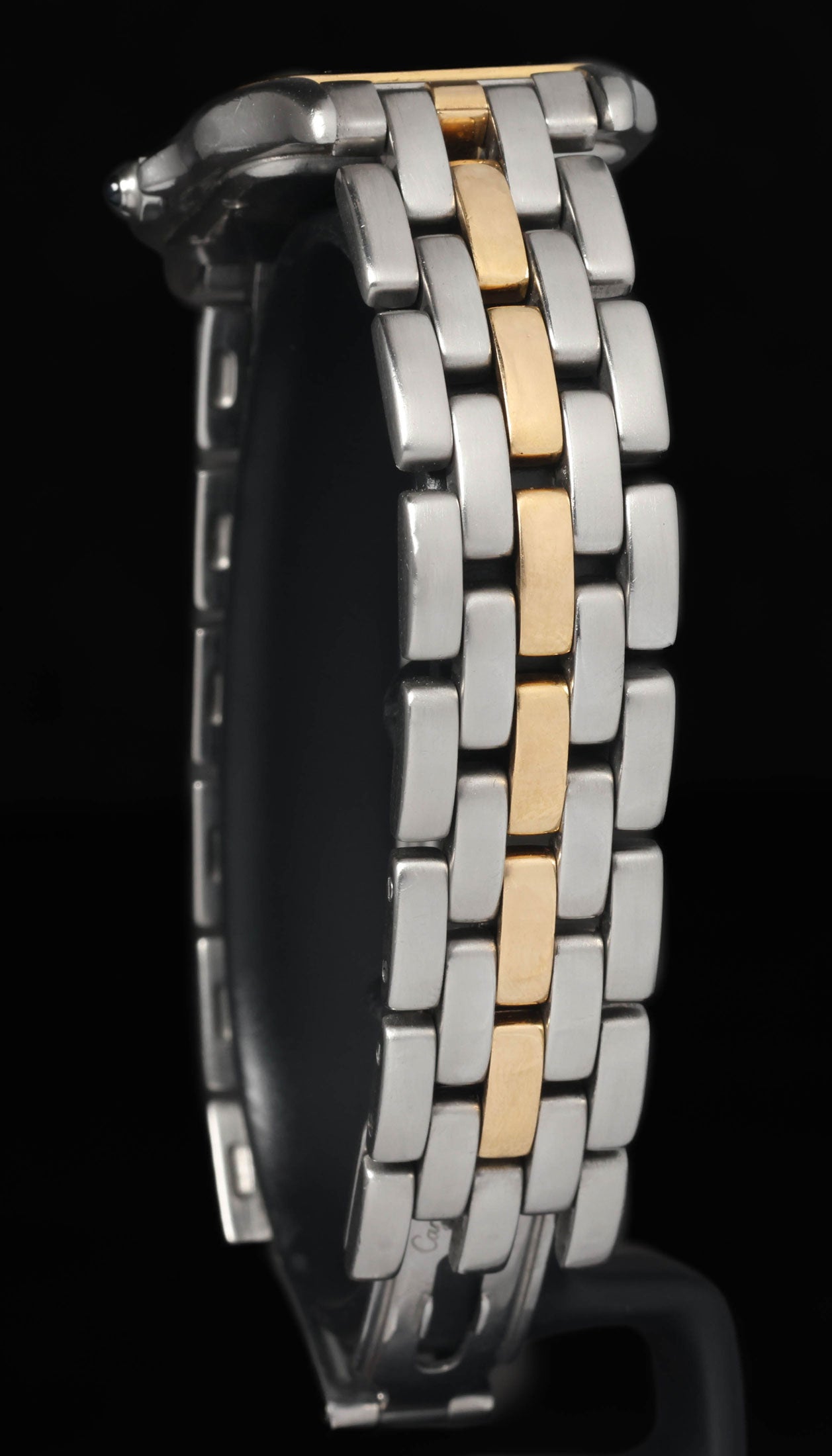Crown Vintage
Cartier Panthere Date 1100 27MM Circa 1990s
Cartier Panthere Date 1100 27MM Circa 1990s
Couldn't load pickup availability
Cartier Panthere Date 1100 27MM Circa 1990s
The stainless steel and yellow gold case remains in great vintage condition, with hairline scratches visible around the surfaces consistent with careful wear over time. The case lines retain strong definition, showing no signs of heavy polishing.
The two-tone bracelet is in good condition, displaying hairlines across the gold centre links and steel outers. Some stretch is present, as expected for a watch of this age, but it remains structurally sound and comfortable on the wrist.
The white dial is excellent, with crisp black Roman numerals, an intact chemin-de-fer minute track, and the signature Cartier blue steel hands in flawless form. Both the dial and hands present without blemishes or notable ageing, retaining their original vibrancy and elegance.
Overall, this Cartier Panthère Date 1100 presents as a well-preserved example, maintaining its distinctive two-tone character and timeless design. As the watch is over 30 years old, it should be treated as a vintage timepiece and not worn while swimming, even though it was originally built with practical durability in mind.
Share
Why we love this watch
Why we love this watch
Cartier Panthère Date 1100 from the 1990s
Introduction
The Panthère line had already established itself as a defining symbol of Cartier’s design sensibility by the 1980s, bridging the brand’s historic jewellery codes with modern horology. The reference 1100, offered in a stainless steel and yellow gold two-tone configuration with a date complication, captured the essence of that era—luxurious yet wearable, bold yet refined. This model was conceived at a time when Cartier was expanding its reach in global markets, and it epitomises how the brand managed to balance its status as a jeweller with its growing reputation as a watchmaker.
The Panthère was never intended to compete with the technical innovation of Swiss maisons like Patek Philippe or Audemars Piguet. Instead, it was an exercise in design coherence, in creating a piece that was as much jewellery as it was a functional timekeeper. By the time the 1100 arrived in the 1990s, Cartier had refined this approach, making the Panthère one of its most commercially and culturally successful collections.
The Origins of the Panthère Collection
The Panthère was launched in 1983, when Cartier sought to modernise its watch offerings. The collection drew direct inspiration from the earlier Santos, a watch designed in 1904 for aviator Alberto Santos-Dumont. The Santos had already set the template with its square case, exposed screws, and integrated bracelet, and the Panthère built upon this blueprint.
What distinguished the Panthère was its softer, more sensual lines. Where the Santos was bold and industrial, the Panthère was fluid, elegant, and unmistakably Cartier in its jewellery-first aesthetic. The bracelet was a triumph of design, with its rounded, flexible links that moved like fabric on the wrist. This tactile quality, combined with the slim profile of the case, made the Panthère a watch that could be worn in formal and casual settings alike.
By the 1990s, the Panthère had become one of Cartier’s signature designs. It was embraced not only by those who saw Cartier as a jeweller but also by a generation of professionals and tastemakers who appreciated the clean geometry, luxury finishes, and discreet branding. The Panthère 1100 embodied this blend perfectly, arriving in a two-tone execution that echoed the broader style codes of the decade.
Cartier in the 1990s
The 1990s were pivotal for Cartier. Having spent much of the 20th century focused on jewellery, the Maison redoubled its efforts in horology during the late 1970s and 1980s. By the 1990s, Cartier’s watch collections were firmly entrenched in the global luxury watch market, competing not through technical wizardry but through unmistakable design.
The Panthère sat alongside other important Cartier models such as the Santos Galbée, Tank Américaine, and Pasha, each of which catered to a slightly different clientele. The Panthère was marketed as a watch for those who wanted a jewellery piece that could function as an everyday wristwatch. It was worn by men and women alike, although the smaller sizes and two-tone finishes of references like the 1100 made it particularly appealing to those who sought refinement over size.
During this period, Cartier’s watches reflected the broader aesthetic of the 1990s: slim profiles, two-tone metals, and design coherence over excessive complication. The Panthère Date 1100 captured this mood precisely, offering a reliable quartz movement with the added practicality of a date function, all wrapped in a case and bracelet that exuded Parisian elegance.
The Cartier Panthère Date 1100 – Design and Details
The reference 1100 is a 27mm watch that embodies Cartier’s approach to form and proportion. Its square case, softened by rounded edges and accented by exposed screws on the bezel, carries forward Cartier’s Santos DNA but in a more jewellery-like execution. The case thickness is slim, allowing the watch to slip easily under a cuff, which was a key requirement for the professional style of the 1990s.
The two-tone construction is central to the appeal of the 1100. Stainless steel forms the base, while yellow gold accents appear on the bezel screws, crown, and central bracelet links. This combination captured the decade’s fascination with bi-metal luxury, offering both versatility and presence. The bracelet itself remains one of Cartier’s finest designs, with links that flow seamlessly and articulate smoothly, providing a comfort that few integrated bracelets of the era could match.
The dial is pure Cartier. White with black Roman numerals, it retains the signature chemin-de-fer minute track and blue steel sword hands. At three o’clock, the date aperture is neatly integrated, adding practicality without disrupting the symmetry. The sapphire cabochon set into the crown is another Cartier hallmark, a detail that elevates the watch from simple accessory to design icon.
While many Panthère models were time-only, the inclusion of a date on the 1100 gave it a slightly more utilitarian edge. It was a nod to practicality that suited the lifestyle of the 1990s professional, for whom the Panthère was both an expression of taste and a daily companion.
Movement and Functionality
The Cartier Panthère Date 1100 is powered by a quartz movement, which was the standard for this model in the 1990s. Quartz movements had become widely accepted in luxury watches by this time, especially for designs aimed at those who prioritised elegance and convenience. Cartier made the deliberate choice to house the Panthère in quartz form, ensuring slim proportions and absolute reliability.
The quartz movement allowed Cartier to maintain the Panthère’s slender case, an essential part of its design. Mechanical calibres of the period would have required greater thickness, disrupting the refined profile. Furthermore, quartz enabled precise timekeeping with minimal maintenance, a factor that resonated with Cartier’s clientele of the period.
The date complication was executed cleanly, with a crisp changeover and legible display. While Cartier was not competing on the level of haute horlogerie technical achievement, the execution was flawless in terms of finishing and reliability, aligning perfectly with the Panthère’s role as a luxury jewellery watch.
The Panthère in Popular Culture
The Cartier Panthère was not only a commercial success but also a cultural one. It became a symbol of the 1980s and 1990s, appearing on the wrists of celebrities, business leaders, and style icons. The fluid bracelet and recognisable square case made it instantly identifiable, and it was often associated with an understated form of wealth.
The two-tone reference 1100 fit perfectly into this narrative. During the 1990s, two-tone watches were seen as the height of sophistication, balancing precious metal luxury with stainless steel practicality. The Panthère became a staple in advertising campaigns of the decade, its imagery tied to Cartier’s positioning as both jeweller and watchmaker.
The Panthère was marketed as a unisex model, and its smaller sizes—like the 1100—were particularly popular with women. At the same time, the watch’s design coherence and practical date function ensured it appealed to men who preferred elegance over bulk. This versatility contributed to its widespread success.
Historical Significance of the Panthère Date 1100
The Panthère 1100 is significant for several reasons. Firstly, it represents the continuation of Cartier’s design philosophy that prioritises form and style as much as function. The watch was never about technical superiority; it was about expressing Cartier’s unique identity within the watch world.
Secondly, the Panthère marked an era when Cartier successfully transitioned from being seen primarily as a jeweller to being acknowledged as a serious watchmaker. While purists may argue that quartz-powered watches lack mechanical prestige, Cartier’s ability to create a watch that was desirable, wearable, and instantly recognisable ensured its success.
Thirdly, the Panthère 1100 embodies the aesthetics of its decade. The two-tone bracelet, Roman numeral dial, and quartz functionality all speak to the style codes of the 1990s. For those looking back at that period, the Panthère remains one of the quintessential luxury watches of the time.
Finally, the Panthère is a reminder of Cartier’s ability to blend jewellery and horology seamlessly. Few other brands could create a watch that felt equally at home in a jewellery boutique as in a watch salon. The Panthère Date 1100 is a perfect expression of this duality.
The Bracelet – Cartier’s Masterstroke
Any discussion of the Panthère must devote attention to the bracelet. The flowing link design was a revelation in the 1980s and continued to define the watch in the 1990s. Its supple construction gave it the feel of a chain bracelet rather than a traditional watch strap, which was central to its jewellery-inspired appeal.
The two-tone bracelet of the 1100 is particularly striking. The yellow gold centre links catch the light, while the stainless steel outer links provide balance and wearability. This combination not only made the watch versatile in terms of wardrobe pairing but also ensured that it retained its luxury appeal without being ostentatious.
Cartier’s mastery of proportion is evident in the bracelet’s integration with the case. The transition is seamless, maintaining the watch’s flowing aesthetic. Even today, few bracelets rival the comfort and elegance of the Panthère’s design.
Cartier’s Panthère and the Evolution of Luxury Watches
The Panthère 1100 must also be considered within the broader context of luxury watchmaking. In the wake of the quartz crisis of the 1970s, many Swiss brands struggled to redefine themselves. Cartier, however, embraced quartz as part of its identity, choosing to emphasise jewellery design rather than compete directly in the arena of mechanical complications.
This strategy proved highly successful. By the 1990s, Cartier had secured its place as one of the largest luxury watch brands in the world, driven in no small part by the Panthère. The 1100, with its blend of steel, gold, and quartz precision, was emblematic of how Cartier turned the challenges of the quartz era into an opportunity.
It is also notable that the Panthère blurred the line between men’s and women’s watches, something that was rare at the time. The 1100’s 27mm size might feel small by contemporary standards, but in the 1990s it struck the perfect balance of elegance and discretion.
Final Thoughts
The Cartier Panthère Date 1100 from the 1990s is far more than a watch—it is a snapshot of Cartier’s design evolution and the era in which it thrived. With its two-tone bracelet, slim case, and quartz precision, it embodies the values of the time: elegance, convenience, and subtle luxury.
The watch represents a turning point for Cartier, showcasing how the brand leveraged its jewellery heritage to create watches that appealed to a global audience. The Panthère’s supple bracelet, Roman numeral dial, and signature cabochon crown remain iconic elements that continue to resonate today.
Case & Bracelet
Case & Bracelet
Case in great vintage condition, hairline scratches visible around the case, consistent with careful wear. Two-Tone bracelet in good condition, hairlines visible with some stretch.
Dial & Hands
Dial & Hands
Dial & hands excellent
Warranty & Condition
Warranty & Condition
Crown Vintage Watches provides a minimum 3-month mechanical warranty on pre-owned watches, from the date of purchase.
The warranty covers mechanical defects only.
The warranty does not cover damages such as scratches, finish, crystals, glass, straps (leather, fabric or rubber damage due to wear and tear), damage resulting from wear under conditions exceeding the watch manufacturer’s water resistance limitations, and damage due to physical and or accidental abuse.
Please note, water resistance is neither tested nor guaranteed.
Shipping and insurance costs for warranty returns to us must be covered by the customer. Returns must be shipped via traceable courier. Return shipment must be pre-paid and fully insured. Collect shipping will be refused. In case of loss or damages, the customer is liable.
Our Pledge
At Crown Vintage Watches, we stand by the authenticity of every product we sell. For added peace of mind, customers are welcome to have items independently authenticated at their own expense.
Condition
Due to the nature of vintage timepieces, all watches are sold as is. We will accurately describe the current condition and working order of all watches we sell to the best of our ability.
Shipping & Refund
Shipping & Refund









